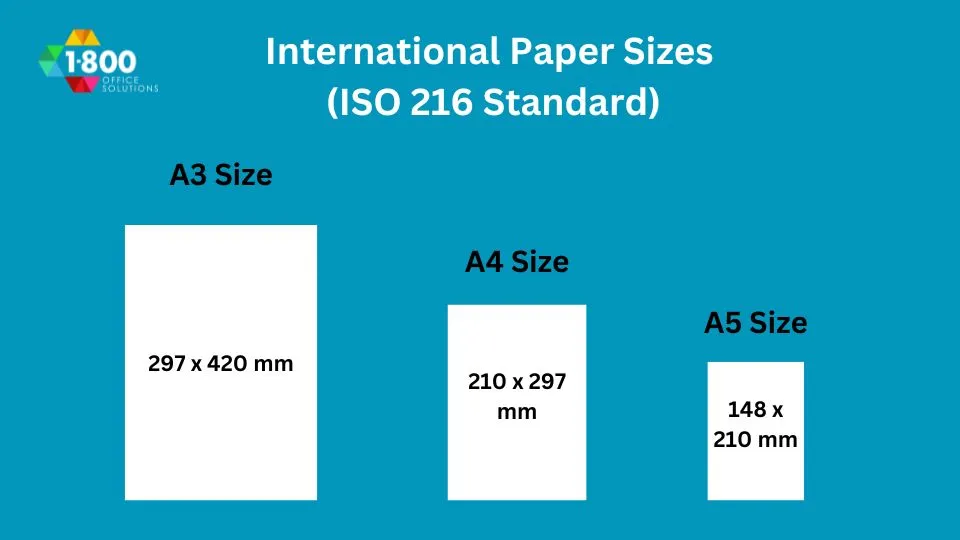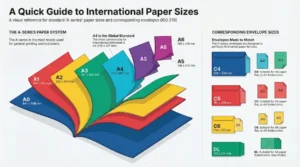Is A3 Bigger Than A4? A Guide on Paper Sizes
Table Of Contents:
Is A3 Bigger Than A4? Complete Comparison of Dimensions, Uses, and Differences
Understanding the difference between A3 and A4 paper sizes is essential—not only for printing and graphic design purposes but also for ensuring that projects conform to international standards. With standardized dimensions set by ISO 216, the A series paper sizes are widely used across many industries, from graphic design and engineering to everyday office work. This article provides a comprehensive comparison of A3 and A4 by examining their dimensions, differences in area and proportions, typical uses, and the ISO standards that govern them. Business owners, office equipment suppliers, and design professionals will find this review useful when considering printing formats, copier leases, commercial copier lease quote, and design layouts. For further inquiries or clarification, please contact your local office equipment supplier. Practical conversion tips, data comparison tables, and FAQs are also included to help you make the ideal choice.
Transitioning from these introductory remarks, let’s dive into the exact numerical details that differentiate these two popular paper sizes.
What Are the Exact Dimensions of A3 and A4 Paper Sizes?
A3 paper is notably larger than A4, following the ISO 216 principle where each size scales by the square root of 2. A3 measures 297 mm in width by 420 mm in height (approximately 11.7 inches × 16.5 inches), while A4 measures 210 mm by 297 mm (roughly 8.3 inches × 11.7 inches). These dimensions make A3 suitable for projects requiring a larger canvas, whereas A4 is optimized for everyday documentation.
What Is the Size of A3 Paper in Millimeters and Inches?
At 297 mm by 420 mm (or about 11.7 inches by 16.5 inches), A3 provides extra space for detailed projects such as posters, brochures, and technical drawings. The larger dimensions ensure that text and graphics remain legible even in more complex layouts, making it ideal for architectural drawings and engineering schematics.
What Is the Size of A4 Paper in Millimeters and Inches?
A4, the most common paper size for official documents and everyday printing, measures 210 mm by 297 mm (approximately 8.3 inches by 11.7 inches). Its compact size is advantageous for storage, filing, and mass printing, fitting well into standard binders and filing systems.
How Do A3 and A4 Paper Sizes Compare Side-by-Side?
When placed side-by-side, two A4 sheets along their longer edge equal one A3 sheet. A3 is exactly twice the area of A4, which provides a more impactful visual presentation and additional space for information. This proportional relationship, defined by ISO 216, ensures that documents can be scaled up or down without losing the correct aspect ratio.
How Much Bigger Is A3 Compared to A4?

A3 paper is exactly twice as large as A4. This is due to the ISO 216 standard that maintains a constant aspect ratio of √2:1. With A4’s area roughly 62,370 mm² and A3’s area about 124,740 mm², designers can confidently upscale layouts while preserving clarity.
What Is the Area Difference Between A3 and A4 Paper?
Multiplying the dimensions of A4 (210 mm × 297 mm) gives an area of about 62,370 mm². Doubling that area results in A3’s approximate area of 124,740 mm². This doubling enables more elements—such as photographs, charts, and text—to be added without cluttering the page.
How Does the Width and Height of A3 Exceed A4?
A3’s width (297 mm) is about 42% wider than A4’s (210 mm), and its height (420 mm) is roughly 41% taller than A4’s (297 mm). These proportional increases allow for uniform scaling of images and text, ensuring that design integrity is maintained when moving between sizes.
Why Is A3 Considered Larger Than A4?
Beyond its double area, A3 offers additional design flexibility. The extra space facilitates larger fonts, high-resolution images, and complex layouts. This makes it an excellent choice in marketing, architecture, and other fields where visual impact and detail are paramount.
What Are the Common Uses of A3 and A4 Paper?
The choice of paper size depends on the intended application. A3 is ideal for documents that require expansive visual space, while A4 is better suited for everyday office tasks.
What Are Typical Applications for A3 Paper?
A3 is preferred for large-format applications such as architectural blueprints, engineering drawings, posters, and technical schematics. Its generous dimensions allow for detailed graphics and creative layouts, making it popular in graphic design and educational projects like lesson plans and student presentations.
What Are Typical Applications for A4 Paper?
A4 is the standard size for letters, memos, reports, and invoices. Its portability and practicality make it ubiquitous in offices and schools, where it supports efficient document processing and storage. Its balanced size is particularly effective for desktop publishing and routine printing jobs.
When Should You Choose A3 Over A4 for Printing and Design?
Select A3 when you need a larger format for intricate diagrams, high-impact posters, or detailed presentations that require enhanced visual clarity. In contrast, A4 is optimal for standard business documents and situations where space conservation is critical.
How Does the ISO 216 Standard Define A3 and A4 Paper Sizes?

ISO 216 standardizes paper sizes by using the property that the aspect ratio remains constant at √2:1. This ensures that every A size is a scaled version of any other, allowing for seamless enlargement or reduction without distortion. This standardization is fundamental to international document compatibility.
What Is ISO 216 and Why Is It Important for Paper Sizes?
ISO 216 is the international standard that governs paper dimensions for the A and B series. Its logical scaling system—where A4 is derived from A0 by repeated folding—benefits manufacturers, printers, and designers by ensuring consistency and predictable outcomes in document creation.
How Are A3 and A4 Paper Sizes Standardized Under ISO 216?
Under ISO 216, each paper size is produced by halving the previous size along its shorter edge. This guarantees that the aspect ratio of 1:√2 is maintained, making it easier to upscale or downscale documents while preserving layout integrity.
How Does ISO 216 Affect International Paper Size Usage?
The adoption of ISO 216 worldwide means that A4 is the standard size for most documentation outside North America. This universality simplifies cross-border communication, technical drawing exchanges, and standardized printing processes, ensuring documents look consistent no matter where they are produced.
How Can You Convert Between A3 and A4 Paper Sizes?
Conversion between A3 and A4 is straightforward due to their proportional relationship. Because A3 is exactly twice the area of A4, conversion involves either doubling or halving the dimensions while retaining the 1:√2 aspect ratio.
What Is the Paper Size Conversion Process Between A3 and A4?
To convert A4 to A3, simply place two A4 sheets side-by-side along their longer edge. Conversely, splitting an A3 sheet along its longer side produces two A4 sheets. In digital design software, automatic scaling tools enable easy conversion without altering the layout.
Are There Tools to Help Convert A3 to A4 and Vice Versa?
Numerous tools—such as modern printers, photocopiers, and design software like Adobe InDesign or Microsoft Publisher—provide built-in options for converting between A3 and A4. These tools help maintain accurate proportions and simplify the conversion process.
How Do Inches and Millimeters Affect Paper Size Conversion?
While ISO 216 specifies dimensions in millimeters, many regions use inches. With one inch equal to 25.4 millimeters, careful conversion ensures that digital designs and printed documents remain consistent regardless of the measurement system used.
What Are Frequently Asked Questions About A3 and A4 Paper Sizes?
The following FAQs address common queries regarding measurements, conversions, and practical uses of A3 and A4 paper sizes.
Is A3 Bigger Than A4?
A: Yes, A3 is bigger than A4. An A3 sheet is exactly twice as large as an A4 sheet, with dimensions of 297 mm by 420 mm compared to A4’s 210 mm by 297 mm. This follows the ISO 216 scale.
What Are the Dimensions of A3 Paper in Inches?
A: A3 measures approximately 11.7 inches by 16.5 inches, based on its metric dimensions of 297 mm by 420 mm, providing a larger canvas for detailed designs and technical drawings.
What Are the Dimensions of A4 Paper in Inches?
A: A4 measures roughly 8.3 inches by 11.7 inches, making it ideal for everyday office printing, letters, and documents.
What Are the Differences Between A3 and A4 Paper?
A: A3 is twice the area of A4 and has larger dimensions, making it suitable for detailed visual applications such as posters and blueprints, while A4 is better for routine documentation and printing.
How Do Printing and Design Industries Use A3 and A4 Paper Sizes Differently?
Industries choose between A3 and A4 based on the visual space required and the purpose of the document. A3 is used for large, detailed prints and visual displays, whereas A4 is preferred for everyday business needs.
Why Do Printers Prefer A3 for Posters and Large Documents?
A3’s larger canvas accommodates more content without compromising clarity. Its size supports larger fonts and images, making it ideal for posters, brochures, and detailed charts that need to be viewed from a distance.
How Is A4 Paper Used in Offices and Everyday Documents?
A4 is the standard in offices for reports, memos, and letters. Its convenient size ensures smooth workflow in copiers and printers and fits well in common storage solutions.
What Are Trends in Printing Technology Affecting A3 and A4 Usage?
Modern digital printing has increased the use of large-format A3 prints for marketing and technical presentations, while A4 remains dominant in routine document production. Multifunctional printers now easily switch between sizes, supporting both high-impact visuals and standard business documents.
Table: Comparison of A3 and A4 Paper Sizes
Before exploring further aspects, consider the following table summarizing key differences:
The table highlights the differences and clarifies how each size is utilized, emphasizing the importance of selecting the correct paper size for each project.
Following the table, note that these specifications influence both design layouts and overall printing cost efficiency, important for budget planning and copier lease quotes.
Final Thoughts
A3 paper is indisputably larger than A4, offering double the area and more space for creative design, technical drawings, and marketing materials. While A4 remains the popular choice for everyday documents due to its convenience and portability, A3 is ideal when larger, detailed presentations are needed. The ISO 216 standard guarantees that both sizes maintain a consistent aspect ratio, allowing seamless conversion between formats without distortion. Ultimately, the decision between A3 and A4 depends on the project’s specific requirements for detail and ease of handling.
Frequently Asked Questions
What is the main difference in area between A3 and A4 paper?

A3 paper is exactly twice the area of A4 paper because it is derived by halving the size of a larger sheet, following the √2 aspect ratio defined by ISO 216.
Can documents designed on A4 be resized to A3 without affecting layout quality?
Yes, documents can be upscaled from A4 to A3 while preserving the layout, as conversion maintains the same aspect ratio defined by ISO 216.
Why is A4 considered more portable than A3 for everyday use?
A4’s dimensions (210 mm x 297 mm) make it easier to store and handle, fitting well in filing systems and office equipment, whereas A3’s larger size is more suited to detailed or illustrative documents.
What industries benefit most from using A3 paper sizes?
Industries such as architecture, engineering, graphic design, and advertising benefit from A3 because its larger dimensions support detailed diagrams, posters, and technical drawings that require high resolution.
How does ISO 216 ensure consistency in paper sizes internationally?
ISO 216 standardizes paper sizes with a fixed aspect ratio of √2:1, ensuring each size is a scaled version of the others and providing uniformity across global document production.
Are there any software tools recommended for converting between A3 and A4 sizes?
Yes, many programs like Adobe InDesign, Illustrator, and Microsoft Publisher include built-in conversion tools that automatically adjust dimensions while maintaining the correct aspect ratio.
How do printing costs compare between A3 and A4, and what factors should be considered?
Printing on A3 typically costs more due to the increased material usage, but the decision should also factor in the document’s purpose, the need for visual impact, and potential savings from reduced reprints in high-quality applications.











